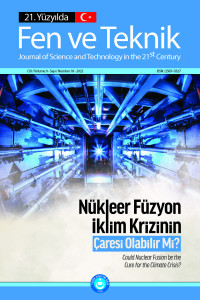Dispersif Sivi Sivi Mikro Ekstraksiyon Yöntemi İle Kobalt(Ii)’Nin Zenginleştirilmesi Ve Alevli Atomik Absorpsiyon Spektrometresi İle Tayini
Bu çalışmada, dispersif sıvı sıvı mikroekstraksiyon ile kobaltın zenginleştirilmesi ve ayrılması amacıyla ligand olarak sodyum dietilditiyokarbamat (NaDDC) kullanılarak kobalt(II)’nin su
ve çay örneklerinde FAAS ile tayini için yöntem araştırılmıştır. Kobaltın geri kazanma verimi üzerine etkilerinin araştırılması için pH, ligant miktarı, dispersif ve ekstraksiyon çözücü türleri
ve miktarları gibi değişkenler optimize edilmiş, yabancı iyon etkileri incelenmiştir. Analiz için uygun pH 2 olarak belirlenmiştir. Ekstraksiyon çözücüsü olarak etanol, dispersif çözücü olarak
karbontetraklorür seçilmiştir. Belirlenen optimum şartlarda kobalt için %95 güven seviyesinde geri kazanma verimi %96±3, gözlenebilme sınırı (LOD) 41 μg/L, tayin sınırı (LOQ) 136 μg/L
olarak hesaplanmıştır. Yöntemin doğruluğu standart referans maddeler ile kontrol edildi. DLLME ve FAAS’nin birleştirilmesi, kobalt tayini için kolay uygulanabilir, az maliyetli ve hızlı bir yöntemdir.
Anahtar Kelimeler:
Dispersif sıvı-sıvı mikroekstraksiyon, zenginleştirme, kobalt, FAAS, Dispersif sıvı-sıvı mikroekstraksiyon, zenginleştirme, kobalt, FAAS
Enrichment of Cobalt(Ii) By the Method of Dispersive Sivi Sivi Micro Extraction And Determination By Flame Atomic Absorption Spectrometer
In this work, the method was investigated for the determination of cobalt (II) in water samples and tea samples with FAAS using sodium diethyldithiocarbamate (NaDDC) as ligand, in order to enrich and separate cobalt by dispersive liquid fluid microextraction. Variables such as pH, ligand amount,dispersive and extraction solvent types and amounts were optimized and the effects of foreign ions were examined in order to investigate the effects on recovery of cobalt. It was determined that the appropriate pH for analysis was 2. Ethanol was selected as Extraction solvent, carbon tetrachloride was selected as the dispersive solvent. In the specified optimum conditions, for cobalt has calculated the recovery yield at 95% confidence level as 96±3%, the limit of detection (LOD) 41 μg/L, the limit of quantification (LOQ) 136 μg/L. The correctness of the method was checked with standard reference material. The coupling of the DLLME and FAAS is easy to implement for the cobalt determination, it is a low cost and quickly method.
Keywords:
Dispersif sıvı-sıvı mikroekstraksiyon, zenginleştirme, kobalt, FAAS,
___
- Abdolmohammad-Zadeh, H., Ebrahimzadeh, E. (2010). Determination of cobalt in watersamples by atomic absorption spectrometry after pre-concentration with a simple ionic liquid-based dispersive liquid- liquid micro-extraction methodology. Central European Journal of Chemistry, 8(3), 617-625.
- Altundağ, H.(2007). Katı Faz Ekstraksiyon Tekniği ile Talyum Türlendirme Çalışması,Doktora Tezi, Sakarya ÜniversitesiFen Bilimleri Enstitüsü, Sakarya.
- Baliza, P.X., Teixeria, L.S.G. and Lemos, V.A. (2009). A procedure for determination of cobalt in water samples after dispersive liquid-liguid microextraction, Microchemical Journal, 93, 220-224.
- Barahona, F., Gjelstad, A., Pedersen-Bjergaard, S. and Rasmussen, K. E. (2010). Hollow fiberliquid- phase microextraction of fungicides from orange juices. Journal of Chromatography A, 1217(13), 1989-1994.
- Dos Silva, E.S., Correia, L.O., Dos Santos, L.O., Dos Santos Vieira, E.V. and Lemo, V.A. (2012). Dispersive liquid-liquid microextraction for simultaneous determination of cadmium, cobalt, lead and nickel in water samples by inductively coupled plasma optical emission spectrometry. Microchim. Acta, 178(3), 269-275.
- Gharehbaghi, M., Shemirani, F. and Baghdadi, M. (2008). Dispersive liquidliquid microextraction and spectrophotometric determination of cobaltin watersamples. International Journal of Environmental Analytical Chemistry, 88(7), 513-523.
- Ghiasvand, A.R., Shadabi, S., Mohagheghzadeh, E. and Hashemi, P., (2005).Homogeneous liquid–liquid extraction method for the selective separation and preconcentration of ultra trace molybdenum.Talanta, 66(4), 912-916.
- Minczevski, J., Chwastowska, J., and Dybezynski, R., (1982). Separation andpreconcentration methods in ınorganic trace analysis.New York:John Willeyand Sons.
- Özkan, B.(2002). İyon Değiştirici Reçinelerle Atık Sularda AAS Kullanarak Cr (III) ve Cr (VI) Tayinleri, Yüksek Lisans Tezi, Erciyes Üniversitesi Fen BilimleriEnstitüsü, Kayseri, 63.
- Ojeda, C.B., Sánchez Rojas, F. (2014). Evaluation of dispersive liquidliquid microextraction for the determination of cobalt and cadmium by flame atomic absorptionspectrometry: application in water and food samples. Sample Preparation, 2(1), 13 -20.
- Rezaee, M., Assadi, Y., Hosseini, M. R. M., Aghaee, E., Ahmadi, F. and Berijani,S., (2006). Determination of organic compounds in water using dispersive liquidliquid microextraction. Journal of Chromatography A, 1116(1–2), 1–9.
- Rezaee, M., Yamini, Y. and Faraji, M., (2010). Evolution of dispersive liquid-liquid microextraction method. Journal of Chromatography A, 1217, 2342-2357.
- Vandecasteele, C., and Block C.B., (1997). Modern methods for trace element determination.Chichester: John Wiley and Sons,1-7.
- Sorouraddin, M.H. Khoshmaram, L. (2010). Combination of dispersive liquid-liquid microextraction with flame atomic absorption for determination of trace Ni and Co in water samples and vitamin B12.Journal of the Chinese Chemical Society, 57(6), 1346-1352.
- Zgoła-Grześkowiak, A., Grześkowiak, T., (2011). Dispersive Liquid-Liquid Microextraction, Trend Anal Chem;, 30, 1382–1399.
- ISSN: 2587-0327
- Yayın Aralığı: Yılda 2 Sayı
- Başlangıç: 2014
- Yayıncı: Türk Eğitim-Sen
Sayıdaki Diğer Makaleler
İç Anadolu Bölgesinde Yem Bitkileri Tarımının Genel Durumu, Sorunları ve Çözüm Önerileri
